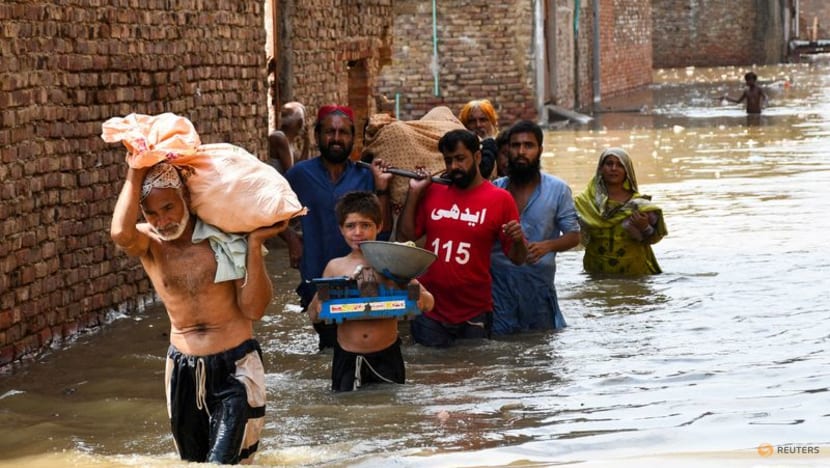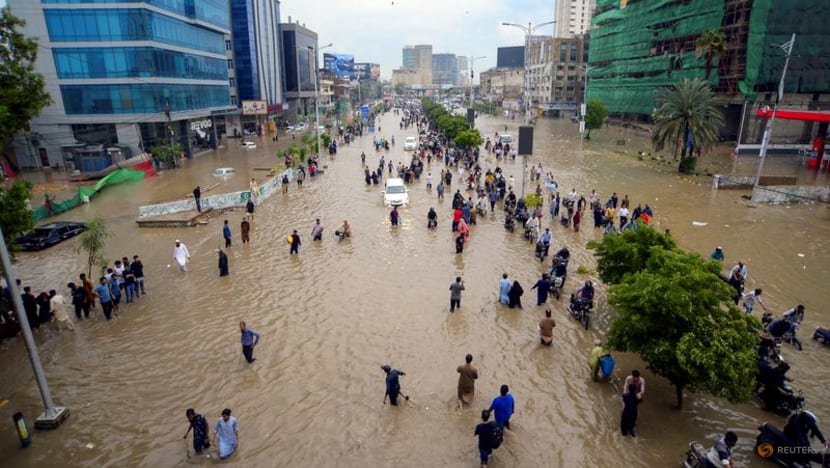As Pakistan battles monsoon floods, experts fear extreme weather will worsen with climate change
Climate scientists blame recurring floods and the high death toll on a combination of factors, including weak infrastructure and melting glaciers.


This audio is generated by an AI tool.
Relentless monsoon downpours that have devastated parts of Pakistan for the past two months are expected to continue until mid-September, the nation’s meteorological office said.
Authorities have warned of two more rain spells in the next few weeks, before the monsoon retreats around Sep 15.
Since June, deadly monsoon rains and flash floods have killed about 800 people across the nation, displaced thousands and destroyed homes and crops.
Affected villages have blamed a lack of weather warnings from the government, as well as insufficient support in the aftermath.
Syed Faisal Saeed, chief meteorologist at the Pakistan Meteorological Department (PMD), said there are communication gaps, especially in mountainous areas where internet coverage is poor.
He added that the department uses other channels to alert local authorities of weather events, but not all residents have the resources to evacuate or take safeguards.
“Sometimes, they don’t take (warnings) seriously … expecting a (high) chance they will survive. Sometimes, they don’t have many options to leave their homes,” he said on Tuesday (Aug 26).
Emergency services and excavation equipment have been unable to reach some areas due to landslides and debris, forcing villagers to claw through rubble by hand to find survivors.
Experts cite climate change as one of the primary drivers for extreme monsoons in Pakistan, raising grim concerns that such events are set to become more frequent and severe.
Saeed said observational data has indicated a shift in monsoon patterns – not only in rainfall volume but also in movement.
“Our monsoon rains are shifting towards the west. Now, the Khyber Pakhtunkhwa province is receiving more rain,” he told CNA’s Asia First programme. The northwestern province, flanked by mountains and glaciers, has suffered the most deaths in this year's monsoons.
“Since 2018, there has been very little (snow) over our mountains, which is exacerbating the situation,” he added.
“Our winter rains are decreasing, and our monsoon rains are increasing. This phenomenon, this pattern is expected to continue in the future. It’s a complete change in the hydrological cycle.”
MELTING GLACIERS & CLOUDBURSTS
Temperatures in Pakistan’s mountainous areas are increasing at an unprecedented rate, rising more than 2.5 degree Celsius in the past 50 years.
Last month, record breaking heat was reported in Chilas, a city in Gilgit-Baltistan located more than 1,000m above the sea level, when the mercury soared to a scorching 48.5 degrees Celsius.
Pakistan is home to more than 7,000 glaciers – the largest number outside the polar regions. As temperatures soar, these rivers of ice are melting rapidly, contributing to flood and landslide risks.
Glaciers and other ice surfaces also reflect 50 to 70 per cent of sunlight into space, preventing the earth from getting warmer.
“As glaciers melt (and) expose land … the earth absorbs more solar radiation and becomes hotter, making the atmosphere more volatile, (causing) events like cloudbursts,” said Fahad Saeed, a senior climate scientist at Climate Analytics.
One of the significant triggers for the recent floods in Pakistan has been an unprecedented number of intense cloudbursts that lead to heavy bouts of rain, causing flash floods.
The country's mountainous topography also creates favorable conditions for the rapid upward movement of humid, moist air that results in cloudbursts, said climate scientist Saeed.
He added it is tough to forecast such weather phenomena in advance as they can happen in areas that do not usually encounter such atmospheric events.
“Cloudbursts happen within the spatial scale of 10km (to) 30km. It's very difficult to predict and that’s (why) it's so hard to respond to. It's beyond the limits of adaptation of a country like Pakistan, both economically as well as technically,” he said.

MORE SEVERE WEATHER AHEAD
Pakistan ranks as the fifth most vulnerable country to climate change, according to the Global Climate Risk Index, facing extreme weather risks like floods, droughts and heatwaves.
In 2022, the nation experienced its most severe monsoon season ever recorded with 1,700 deaths and damages estimated at US$40 billion.
But monsoons are not new to Pakistan – they typically occur every summer from June to September. Hence, expects say there is a need for disaster preparedness measures in place.
The nation's meteorological department is already working on upgrading its early warning system to improve radar coverage, forecast accuracy and now-casting capabilities. The agency, backed by the World Bank, is acquiring new radars and automatic weather stations to install across the nation.
But Pakistan cannot solely depend on early warning systems to manage erratic weather, said PMD's Saeed. He added that the frequent deadly floods during each monsoon season are a “multi-faceted problem”, pointing to illegal deforestation and construction along the riverbeds.
“In future, we will continue to see these types of flash floods because of climate change. We have to do long-term planning and change our lifestyle,” he said.
Yasmeen Lari, co-founder of aid organisation Heritage Foundation of Pakistan, said the country needs to build flood-resilient housing and structures with better foundations and materials.
She added that planting more vegetation can help act as a natural barrier, slowing rainwater runoff and increasing water absorption into the soil.
“Unless we concentrate on making our communities ready and resilient, we will keep on suffering … poverty levels will keep on rising,” said Lari, who is also Pakistan's first female architect.
“We have to change the way we construct … people lose lives because concrete buildings collapse very easily. We should have flood mitigation measures, help communities be prepared, (have) more warning systems.”
PMD’s Saeed said that with diminishing focus and investments from the international community on climate resilience projects, Pakistan needs to depend on itself.
“Pakistan has to take (climate change) very seriously, come up with local solutions with its own resources and give these disasters and (events) related to climate change the top priority,” he said.
















